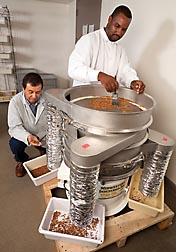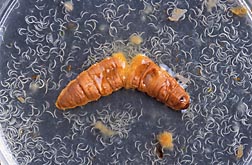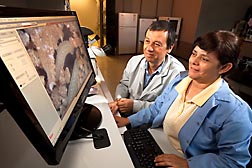Coming to a Field Near You: Taped Insect Cadavers
|
|
The wormlike nematodes from the genera Heterorhabditis and Steinernema are less than 1 millimeter long. But don’t let their small size fool you: Both can bring down prey many times their size. People, plants, and pets aren’t on the menu, though—only the larval stages of Japanese beetles, vine weevils, root borers, fungus gnats, and other insect crop pests.
Heterorhabditis and Steinernema species belong to a small but elite group of entomopathogenic (insect-killing) nematodes whose host-specificity has made them appealing biological alternatives to synthetic pesticides. Liquid formulations, wettable powders, and clay carriers are among products used to apply the nematodes and keep them safe during storage. About 10 years ago, however, an ARS team found that the nematodes perform best when applied to soils while still ensconced in the dead bodies of the insect hosts used to mass-produce them. (See “The Living Dead: What Lurks Inside These Insect Cadavers?” Agricultural Research, May 2002, p. 14.)
ARS entomologist David Shapiro-Ilan did that research with colleagues from ARS and the Virginia Polytechnic Institute and State University in Blacksburg, Virginia, and elsewhere. Shapiro-Ilan is with the Southeastern Fruit and Tree Nut Research Laboratory in Byron, Georgia.
Their approach uses the insect cadavers as a kind of staging ground from which nematodes can venture out when conditions are optimal—or at the prompting of specific chemical cues from their dead host.
Upon locating and penetrating their prey, usually via natural body cavities, the nematodes release symbiotic bacteria. They, in turn, liquefy the insect’s innards, killing it in 24-48 hours. The nematodes feed on the “bacteria-seasoned” remains until all that’s left is an empty shell. Within a week or two, a new generation of juvenile nematodes emerges, ready to start the cycle over again.
An Idea Takes Shape
A technical hurdle that’s kept the insect-cadaver approach from gaining widespread commercial acceptance is the tendency of some commonly used host insects—notably the soft-bodied greater wax moth larvae—to rupture or stick together during storage, transport, and application.
To address this issue, Shapiro-Ilan teamed with Louis Tedders of Southeastern Insectaries, Inc., in Perry, Georgia, and entomologists Juan Morales-Ramos and Guadalupe Rojas—both with ARS’s Biological Control of Pests Research Unit in Stoneville, Mississippi.
The result of that collaboration was an automated system that—in “Dr. Seuss-like fashion,” as Shapiro-Ilan describes it—plucks nematode-infected insect cadavers from a container and deftly sandwiches them between two strands of masking tape. Eventually, an entire roll is formed, allowing for easy storage, transport, and application to pest-infested soils—whether in crop fields, orchards, greenhouses, or gardens.
Customized Insect-Cadaver Taping
Tedders, who had been collaborating with the ARS scientists under a cooperative research and development agreement, originally came up with the cadaver-taping idea. He also devised a prototype machine to automate the process, which Morales-Ramos and Rojas later refined to reduce labor and to standardize the final product. A patent application was filed in 2010.
Choosing the best insect species to use proved a critical early decision. Wax moth larvae had long been the nematode host of choice among insectaries and biopesticide companies, but the cadavers proved unsuitable for taping. “They become fragile and leaky; they’re difficult to handle,” says Morales-Ramos. Instead, the team chose mealworms, whose harder shells can withstand the rigors of carcass taping.
Using off-the-shelf parts purchased from the food-service industry, the Stoneville researchers built a prototype separation device that has blowers and customized screens to mechanically sort the mealworms by size. Previously, this had been done using hand-held screens, which was time-consuming. “Mealworms develop at different rates,” says Morales-Ramos. “The biggest are chosen for nematode infection. Medium-size ones are sold for other purposes. Smaller sizes are returned to the colony to continue growing.”
The mealworms are then placed in shallow plates teeming with hungry nematodes. After a few days, during which the nematodes infect and kill their hosts, a mechanical arm reaches in and places the carcasses between two strips of masking tape at the rate of one insect every 2 seconds. Future versions of the machine could speed the process by placing multiple cadavers simultaneously.
Testing Proves Tape Formulation’s Worth
The next step was to test the tape-delivery system’s ability to protect the cadavers from mechanical damage as well as its nematode yield and pest-control efficacy. “We found that infective juvenile nematode yield was not negatively affected by the tape formulation,” says Shapiro-Ilan.
In laboratory experiments, the group measured survival of two insect pests, the root weevil or the small hive beetle, after the application of two nematode-infected hosts with or without tape in soil-filled 15-centimeter pots.
A greenhouse experiment was conducted in a similar manner to measure survival of the root weevil. “In all experiments, both the tape and no-tape treatments caused significant reductions in pest-insect survival relative to the control, and no differences were detected between the nematode treatments,” says Shapiro-Ilan. “Fifteen days after application, the infected-host treatments caused up to 78-percent control of small hive beetle in the lab, 91-percent control of root weevil in the lab, and 75-percent control of root weevil in the greenhouse. These results indicate potential for using the tape-formulation approach for applying nematode-infected hosts.”—By Jan Suszkiw and Sharon Durham, Agricultural Research Service Information Staff.
This research is part of Crop Protection and Quarantine, an ARS national program (#304) described at www.nps.ars.usda.gov.
To reach scientists featured in this article, contact Jan Suszkiw, USDA-ARS Information Staff, 5601 Sunnyside Ave., Beltsville, MD 20705-5129; (301) 504-1630 [Suszkiw], (301) 504-1611 [Durham], sharon.durham@ars.usda.gov.
"Coming to a Field Near You: Taped Insect Cadavers" was published in the November/December 2011 issue of Agricultural Research magazine.









